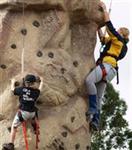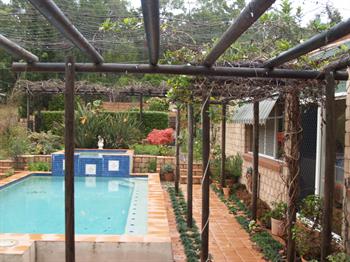Work your way up the recreation ladder and become a recreation facility manager!
Part 1: This course relates to the management and maintenance of both indoor and outdoor facilities and equipment, including swimming pools, locker rooms, buildings, gymnasiums, and sports turf. Content includes monitoring the condition of equipment, routine maintenance programming and simple repair procedures.
Part 2: This course develops a manager's ability to participate effectively as part of a design team for major works, or to plan and direct contractors in the development of minor facilities. It covers:
- Ergononmic considerations
- Managing construction work
- Design of sports grounds
- Design of indoor facilities
- Design of gymnasium equipment
You can study from home at your own pace (which should be quite fast if you're in to fitness) either online or by printed notes.

Lesson Structure
There are 13 lessons in this course:
- Introduction to Facility Management
- Nature and scope of the work
- Developing management procedures
- Quality (compliance) systems
- Water Facilities
- Water treatments: salt, bromine, ozone etc
- pH management
- Control of water temperature
- Filtration systems
- Air maintenance in an indoor pool area
- Routine pool maintenance
- Maintenance of spas, saunas and steam rooms
- Common problems with swimming pools
- Pool surrounds
- Ancillary facilities
- Managing use of swimming pools
- Sports Turf Facilities
- Advantages and disadvantages of turf as a sporting surface
- Turf condition: what affects the condition of turf
- Maintenance practices for turf
- Gymnasiums
- Sports equipment: track, athletics
- Gymnasium maintenance
- Health and safety in a gym
- Gymnasium standards
- Public Buildings
- General building maintenance tasks
- Health and safety issues
- Managing building repairs
- Toilets and Locker Rooms
- Components of toilet locker room areas
- Health and safety concerns
- Routine maintenance
- Introduction to Design
- Design factors
- Types of facilities
- Site selection
- Planning process
- Ergonomics
- Scope and nature of ergonomics
- Understanding posture
- Furniture design
- Ergonomics for a gym
- Layout of interiors
- Outdoor Facilities
- Pool design: Pools and surrounds
- Water slides
- Spas
- Other water features
- Fountains
- Playground design
- Planning for play Community participation
- Park design
- Fitness trails
- Skateboarding
- Multi purpose courts
- Indoor Facilities
- Floors
- Walls
- Lighting
- Heating
- Ventilation
- Use of colour
- Macro design for indoor facilities
- Local community recreation centres
- Interior Design
- Exercise facilities
- The space
- The equipment: types of equipment
- Layout of a gym
- Interior design
- Equipment Design
- Design of fitness equipment
- Exercise bikes
- Rowing machines
- Treadmills Step machines
- Strength training equipment
- Managing Construction
- Nature of the task
- Safety
Each lesson culminates in an assignment which is submitted to the school, marked by the school's tutors and returned to you with any relevant suggestions, comments, and if necessary, extra reading.
Aims
- Identify work tasks involved in the maintenance of recreation facilities.
- Manage the condition of recreational water facilities, including swimming pools.
- Manage the condition of a sports turf facility, including monitoring and maintaining the condition of turf.
- Manage the condition of a gymnasium, including monitoring the condition of structures and equipment.
- Manage the condition of a public building, including monitoring.
- Explain design factors for recreation facilities.
- Explain the concept of ergonomics related to recreation facility design.
- Explain the design of an outdoor recreation facility used in the industry.
- Explain the design of an indoor recreation facility.
- Arrange movable equipment and furnishings in a way to maximise predetermined criteria, including safety and function, within the physical confines of a facility.
- Explain the design of fitness equipment.
- Develop a management strategy for the construction of part, or all, of a recreation facility.
Article by our Principal; John Mason
HOME SWIMMING POOL MAINTENANCE
 Home Swimming pools and spas require constant care. The type of care will depend upon what type of pool you have.
Home Swimming pools and spas require constant care. The type of care will depend upon what type of pool you have.
CHLORINATED OR BROMINED POOLS
These types use a floating chamber that slowly releases the chemical. The controlling valves that open and close ton release the chemicals normally require disassembling and cleaning and the removal of faulty parts. The probe that measures the chemical level often requires cleaning with detergent or weak acid. They do sometimes need replacing too.
SALT WATER POOLS
Salt water pools are becoming increasingly popular. They don’t have the smell of chlorine, and if you close your eyes, you can even believe that you’re swimming at the beach!
Salt water chlorinators will need regular maintenance. Inside the chlorinator cell are platinum-coated titanium plates. These are solid plates in more modern models which makes them easy to clean. Check them for build-up of calcium products.
The salt content of the pool is recycled and will only need topping up about twice a year.
WHAT IS ALGAE?
Algae are a group of primitive plants that grow best in dirty warm water, making them a major problem for many pool owners. Algae can pollute pool water and block water filters. The presence of algae indicates that your pool needs urgent chemical treatment.
THE CONCRETE HOME POOL
If your concrete or pebblecoated wall is stained from algae, salt or dirt, wash them clean with a scrubbing brush or a high pressure water hose.
Pools that are lined with ceramic tiles can sometimes develop cracks in the mortar between the tiles. If this causes tiles to fall off, they can be re-attached with ceramic adhesive.
Painted pool walls will fade over time. Before repainting them, they will have to be thoroughly scrubbed before applying at least two coats of new paint.
Concrete walls can sometimes become cracked due to shifting soil and/or changes in temperature. Small cracks will not usually be of concern, however larger cracks will necessitate emptying the pool. Cement repair compounds can then be used to fill the cracks. If the crack has caused the pool to spring a leak, call in a concreting expert.
THE HOME FIBREGLASS SPA
Prevent greasy marks around the spa edge (particularly in heated water), by wiping it down after use.
Small chips or cracks can appear in a fibreglass spa. You can repair these by removing the damaged area and patching with a fibreglass repair kit. Coloured resin can be included to match the colour of your spa.
THE ABOVE GROUND POOL
Before spending money on repairs to above ground pools, compare the cost of repairs with the cost of replacement. In some instances it will be cheaper to replace than to repair.
If the walls of your above ground pool are warped or collapsing, you will need to empty the pool before beginning repair work. First, check that the problem does not extend below ground. Then, depending upon the extent of the problem, walls can be straightened or replaced. Ensure that the coping that runs around the top of the pool is strong and properly fitted to the wall.
Small holes in the liner can be repaired with a vinyl repair kit. Larger holes will have to be repaired by an expert.
SKIMMER BOXES
The most common problem with skimmer boxes is that the movable door fails. This will not prevent the skimmer box from operating, but can allow dirt to enter the pool when the filter isn’t working. Malfunctioning doors should be replaced.
The skimmer basket should be cleaned regularly and checked for cracks. A damaged skimmer box will allow dirt to enter the pump.
FILTERS
Filters are a very important part of maintaining your pool. Keep your filter working properly, and your pool will be much easier to look after.
Filters with removable cartridges must be checked and the cartridges cleaned regularly with detergent. They should be replaced every two years. If the plastic housing cracks for any reason, it may be possible to replace it without replacing the whole unit. If leaks occur, check the ‘O’ rings used on the valves inside the unit.
Sand filters have to be “backwashed” every two weeks. To see if the sand in your filter needs changing, remove the lid and see if the sand is dirty or tightly packed. If the sand needs changing, it is advisable to employ a pool expert for the task.
PUMPS
Check pumps for blockages from objects such as leaves, and for loose fittings that may let air into the system. For other problems, pumps will have to be removed for servicing.
VACUUMS
Vacuuming the pool (by plugging a suction hose into the pool filter) is an easy way to remove algae, calcium deposits and other dirt without emptying the pool and scrubbing. Regular vacuuming will reduce the likelihood of permanent stains on the pool walls.
LIGHTS
Except in some older pools, underground pool lights operate on low voltage power. Nevertheless, unless you are familiar with electrical wiring and know how your pool lights have been installed, you should employ a qualified electrician to undertake repairs.
HEATERS
Heaters can fail for all types of reasons, depending upon how they operate. If your heater isn’t working properly, use the following checklist:
- Is the switch working?
- Is the pilot light turned on?
- Is the electricity turned on?
- Is there water flowing through the heater? If not, why not?
- Is the thermostat set correctly?
- Is the heating element coated with dirt?
If none of these is the problem, you will need a service call from a gas plumber or an electrician.
Commercial or public pools are a different story again..... Study our Facility Management Course to learn about the development, care and use of these and other commercial and public leisure facilities.